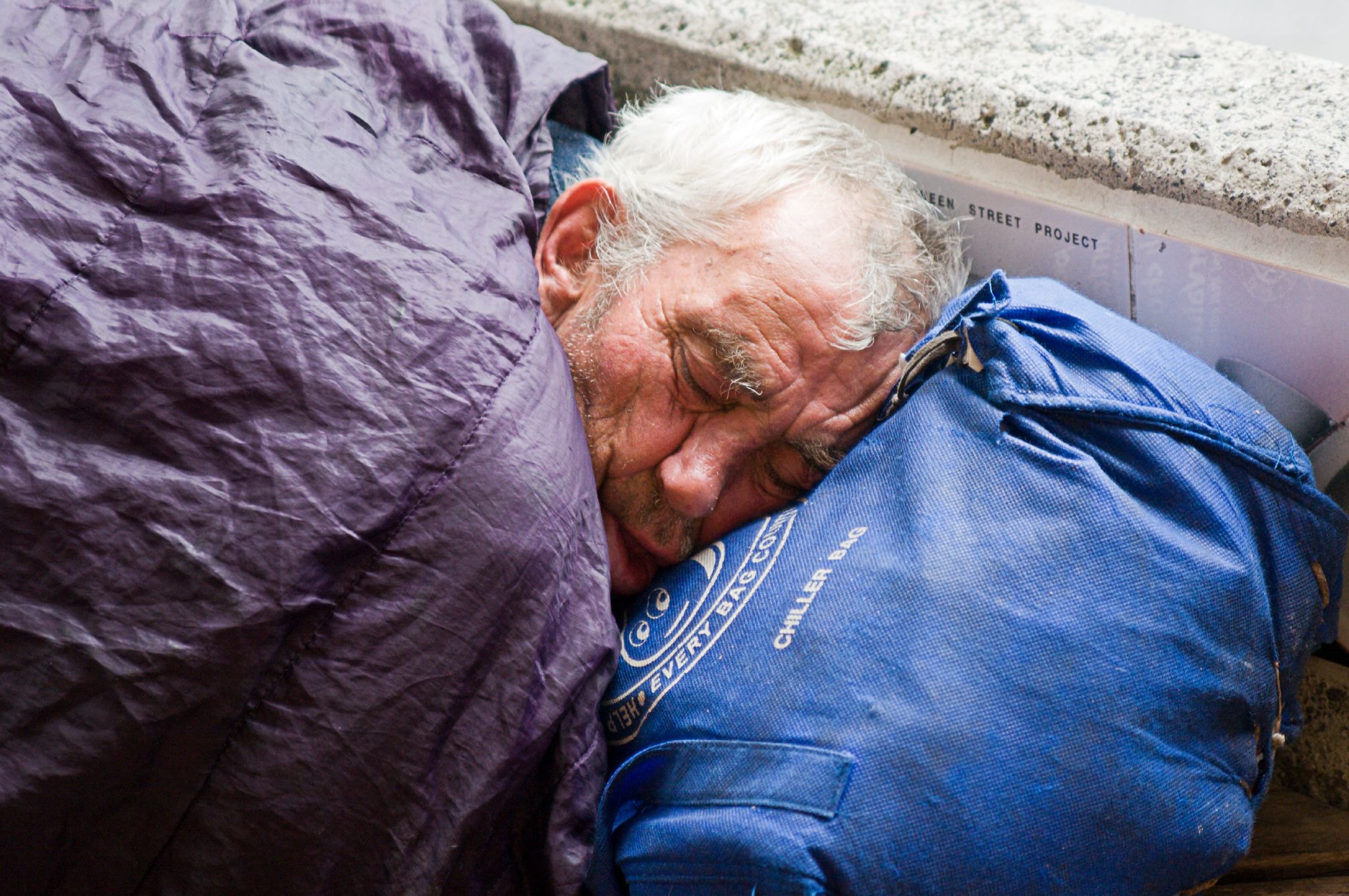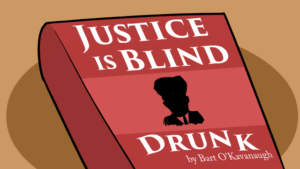A Crash Course on How to Handle Homelessness
Here’s why previous efforts haven’t worked, and what to do instead, from an education gleaned in the streets of Los Angeles. (wonderferret / Flickr)
(wonderferret / Flickr)
I really discovered homelessness for the first time when I left my job at an upscale Hollywood radio station in 1987 to work at a downscale downtown newspaper.
Hollywood certainly had its homeless people, but at that time, in that place, their condition seemed minor, temporary, manageable: street kids, runaways, a smattering of burned-out hippies. Nothing that a little counseling, a little rehab, a little assistance in reconnecting with family members probably couldn’t fix easily enough.
It was certainly nothing systemic. Or so I thought, wrongly. What I’ve learned since is that the issue is far more complex than I could possibly have imagined. There are almost as many causes of homelessness as there are homeless individuals. Their homelessness may not just be a status they temporarily experience; it can become an existential condition, a syndrome they have fallen into that must be addressed incrementally, not a problem that can simply be solved in one swift, bold stroke. Bookshelves are groaning with 10-year plans that failed to deliver, if they were ever implemented at all.
I would eventually discover that it is simply not true that everyone wants to get off the street, clean up, submit to a conventional regimen. Whatever the professional advocates tell you, seasoned social workers know better. There are homeless individuals who genuinely are “service-resistant,” but that implies more agency and volition than many homeless street people actually possess. Even those who sincerely want to escape their homelessness simply may never be able to do what is necessary to regain their autonomy and self-sufficiency.
Liberals and progressives blame Darwinian social policy and the ravages of capitalism. Conservatives blame an indulgent society and personal moral failings. But imposing such an ideological overlay is profoundly unhelpful and leads inevitably to a false binary choice: Either more money or more discipline is needed. A more honest approach recognizes the need for both. Building shelter and providing support services demands more public investment than we historically have been willing to make, but not tending to the plight of people living on the street can no longer be an option for any community. It denotes not respect for their rights, but neglect of our obligations. As a practical political matter, we cannot continue asking the public for more funding without delivering something tangible in return. We must find an ethical and constitutional way to bring the homeless population in off the street.
* * *
When I joined the Los Angeles Herald-Examiner, I got “woke” to the issue pretty fast. The Herald’s once-grand, Julia Morgan-designed building was located at 11th and Broadway, what we used to call the “ass-end” of downtown. It stood barely four blocks from the official boundary of skid row, a 50-square-block area bound by Third and Seventh Streets on the north and south, and by Alameda and Main Streets on the east and west.
In that era, there was no LA Live. There was no Staples Center. There was no new and improved Convention Center. There was only blight, neglect, decay and human wreckage on a scale I could never have imagined, and the local government seemed to be doing nothing about it. There, homelessness was an existential condition, signifying a greater pathology of severe illness, disability and official neglect.
By design, skid row had been left to rot by the city for decades; the policy was containment, not eradication. The strategy called for the city’s Community Redevelopment Agency to subsidize commercial and market-rate residential development in the area, with a token affordable-housing element to grease the approvals. The city would blunt political opposition to the resulting gentrification by throwing a few bucks to the skid row social-service agencies to keep them pacified and hopefully even win their support. The media would play its part by boosting the poverty agencies and their leaders with puffy human-interest features while promoting all the shiny new developments in the business and real estate news. But nothing really changed for the impoverished residents of skid row.
Downtown at that time was represented by Councilman Gilbert Lindsay, the self-proclaimed “Emperor of the Great Ninth District.” Gil was notorious for promoting new development at the expense of providing for displaced populations and offsetting the loss of affordable housing units. He actively resisted bringing more social services to skid row, insisting it would only attract more homeless and discourage the kind of big-ticket skyline he hoped would be his legacy.
In 1988, the 88-year-old Lindsay suffered a stroke but ran for reelection the next year, seeking a seventh term. His endorsement interview with us was a pathetic display. Mentally, he was clearly out of it; his girlfriend, some 50 years younger, perched on his knee for the entire meeting. He was reelected anyway. The following year, he suffered another stroke and died in office. Several years later, his family (represented by Johnnie Cochran) sued the girlfriend for ripping off the estate and won a $235,000 judgment. A 10-foot monument to the “Emperor” stands today in front of the Convention Center.
To say that city leadership was somewhat lacking in those twilight years of Mayor Tom Bradley’s long tenure would be an understatement.
I was shocked and sickened by what I saw downtown. A few months after joining the Herald, in a column titled “Los Angeles Doesn’t Care Anymore,” I had written:
The 1982 film “Blade Runner” has become the catch-all metaphor for the degraded future of urban life in Los Angeles. … The inescapable conclusion after living and working here is that Los Angeles, for all its purported affluence, glamor and sophistication, is becoming a city that is not unable, but unwilling, to care for itself. … On every street I drive, bag people are sleeping on benches, slumped in doorways, or huddled on the sidewalk. … On the radio, their voices plead for shelter and jobs. … I read about them being shuffled from the City Hall lawn to abandoned public buildings to vacant-lot “camps.” A county supervisor proposes to ship them out to a rusty hulk anchored in the LA harbor. One councilmember wants to truck them out to a military base, another would send them to Terminal Island. The city attorney sues the county over the problem.
I concluded: “The larger problem is that some time back, we collectively made an informal, unstated, but nevertheless binding decision to give up trying to make the city work. … The “Blade Runner” analogy actually has it backwards. In the film, frustrated replicant creatures yearn for human love and companionship. The inhabitants of today’s bleak cityscape, by contrast, seem ready to embrace their dehumanized, violent future.”
I wrote that in 1987. “Blade Runner” was set in 2019; its dystopian future is now.
* * *
After the Herald folded in 1989, I joined the office of Third District County Supervisor Ed Edelman. I was now part of a political staff actually trying to do something for homeless people, not just another journalist writing about them.
Ed’s supervisorial district, like Lindsay’s council district, at that time included downtown and skid row. Unlike Lindsay, Ed sincerely tried to improve the situation, but he was constrained by fiscal and political realities. Southern California was sinking into a serious post-Cold War economic recession that was driving up the demand for services while reducing the tax revenue to pay for them. And the Board of Supervisors was then ruled by a conservative Republican majority with little appetite for social-service spending in any event.
Some of it, frankly, was also probably due to a lack of vision. We never tried to reimagine homeless policy or champion major systemic change. We nibbled around the margin, raising the temperature triggers to extend the operating days of cold-weather homeless shelters. We fought against budget cuts to health, mental health care and substance-abuse programs. We tried to publicly shame skid row markets out of further exploiting and immiserating their alcoholic clientele by discouraging their marketing of king-size malt liquor and cheap fortified wines.
We tried, but failed, to avoid a punishing reduction in the county’s general relief payments, the minimal amount of public assistance available to single adults. Over Ed’s objections, the board slashed the monthly relief benefit from a high of $350 in 1991 down to $221, roughly the 1981 level, by scoring the “in-kind” cash value of health services and discounting the monthly cash benefit by that amount. Had we only indexed that 1981 benefit for inflation, relief recipients today would receive $624 per month. As it is, their benefits are only worth $78 in constant 1981 dollars. It is a shame and a scandal that today’s board still has not increased that stipend.
We also struggled over how to identify eligible recipients and quality them for the federal Supplemental Security Insurance program, which would have paid disabled recipients around $900 a month, saving the county money while greatly boosting their public assistance. Today, the internet offers expanded opportunities to accomplish that. But imagine, as a disabled relief recipient, trying to hack your way today through this online bureaucratic thicket to qualify, or getting yourself to a county Department of Public Social Services office to seek help in person.
After a federal civil rights lawsuit redrew the formerly gerrymandered districts and made possible Gloria Molina’s election in 1991, a new Democratic majority emerged. One of its first actions was to settle a five-year lawsuit in which the city and county had sued each other over who bore principal responsibility for addressing homelessness. As part of the settlement, the Los Angeles Homeless Services Authority was created as a joint-powers agency to better coordinate homeless policy. After more than 25 years, about the kindest thing you can say is that it’s still a work in progress—and still has a lot of problems, even as the homeless count continues to swell.
Ed retired from public office in 1994 but continued his homelessness efforts as a consultant to the city of Santa Monica. I joined the staff of his successor, Zev Yaroslavsky (who had earlier also succeeded Ed in his City Council seat). Midway through Zev’s first term, a major fiscal crisis in the county’s health department, with the potential for actually bankrupting the county, took precedence over everything else for several years. That was followed by public safety and law enforcement priorities in the wake of 9/11. It wasn’t until 2004-2005 that the county board began to refocus on homelessness.
In spring of 2006, at the supervisors’ direction, County Chief Administrative Officer David Janssen put forward a comprehensive new Homeless Prevention Initiative (HPI) that identified the three principal factors fueling the homeless crisis: 1) the lack of permanent, affordable housing; 2) insufficient resources and funding to help clients achieve and sustain self-sufficiency; and 3) severe psycho-emotional impairment of clients related to, and exacerbated by, substance abuse and/or mental illness.
The plan, with $100 million in new and previously committed county funding, offered a number of recommendations to address the shortage of emergency, transitional and permanent housing, the need for stepped-up medical care and substance abuse treatment, and assistance in finding housing, qualifying for benefits and dealing with law enforcement and criminal justice issues around homelessness and poverty. Recognizing the regional nature of homelessness, the HPI proposed five regional stabilization centers, one in each supervisorial district, which were intended as alternatives to jail for minor offenses, and for those discharged from jail or county hospitals as an alternative to the street.
Unsurprisingly, none of it was ever implemented. There was so much community opposition that not one stabilization center ever opened, and the rest of the plan fell by the wayside. The money ended up being shoveled instead into existing programs and departments, where it disappeared without a trace.
A year or two later, Zev revived the homeless issue with a bold, and then largely untested, approach: He called it Project 50, a pilot program intended to identify 50 of skid row’s most vulnerable homeless people, those most at risk of dying on the street based on multiple factors including age, health, substance abuse, mental illness and years of living on the street, and bring them into permanent supportive housing (PSH.) It was a “housing first” harm-reduction model, recognizing that they might not be sober and they might still be using, but that it was unrealistic to expect them to clean up on the street before they were eligible to come in out of the cold. If they could get shelter and services first, it would be easier to address their health needs and break the vicious cycle of street, emergency room, court, jail and street again.
The premise was that there were so-called “shot-callers” who functioned as de facto influencers and leaders in the homeless community, and the strategy was that if we could work with them to help cull out and assist the hardest of the hardcore homeless street people, we could certainly succeed with less intractable cases. It would create a new dynamic that would justify scaling up the pilot program to encompass more homeless in other parts of the county.
We also believed it would be less expensive to convert or build, and operate, permanent supportive housing than to keep subsidizing the enormously expensive “frequent flyers” who couldn’t stay out of jail or the ER.
It took months of effort to break down the bureaucratic silos that hampered interagency, law enforcement and judicial cooperation. In addition, what we called the homeless-industrial complex—the network of conventional, long-established soup kitchens, drug and alcohol treatment programs, midnight missions, shelters, transitional housing, community-based health care nonprofits and single-room occupancy operators—fiercely opposed a radically new service model that threatened their standing. They argued that building PSH units would take too long and drain too much money from other vital services, and that housing substance abusers while leaving nonusers out on the street was unfair, sent the wrong message, and would ultimately prove unworkable. And they had the political clout to really monkey-wrench the plan.
Our early evaluations showed that most of the clients were able to stabilize and remain in shelter. With a place to live and better medical treatment, they had fewer brushes with the law and needed fewer costly ER visits. But scaling up proved much more arduous than we anticipated—it was more costly and sparked more community resistance, more law enforcement and judicial opposition when they saw the plan as all carrot, no stick. In 2009, after we had just suffered the worst recession since the Great Depression, the Board of Supervisors balked when asked to expand the successful pilot from Project 50 to Project 500.
That was the last major homeless initiative undertaken before I left the county near the end of 2015. But from August 2015 to February 2016, county agencies mounted yet another County Homeless Initiative and formulated yet another bold new action plan to combat homelessness. Following up on that plan, in November 2016, while the country was electing Donald Trump president, city voters opened their wallets and approved Measure HHH, a $1.2 billion city housing bond that promised 10,000 new permanent supportive housing units within 10 years. Some of us have been deeply skeptical of that boast for some time, and a recent city audit also threw shade on the promise.
Meanwhile, county voters in March 2017 subsequently approved another 10-year homeless funding measure, a countywide parcel tax, which will generate about $355 million a year to be earmarked for a combination of services, rent subsidies and new housing. Its most recently posted roster of funding recommendations largely covers the same well-trod ground as all the other plans and proposals. Will this money be spent any more efficiently and effectively than all those earlier efforts? Will it take us where we need to go?
I don’t think it will. When the city is spending a median cost of $531,000 to develop and construct a single unit of permanent supportive housing that was originally estimated to cost around $350,000-$414,000—and a recent Los Angeles Times analysis concluded that the percentage of street homeless suffering from mental illness and/or substance abuse was more than double LAHSA’s estimated 29%—it’s quite clear that there won’t be nearly enough money to build our way out of homelessness.
But my county experience also revealed a more fundamental dilemma that nobody in government even wants to talk about, much less attempt to address. Even if all the housing were somehow magically to be constructed, and all the social services were to be magically provided, there is no mechanism and no requirement to ensure that homeless people agree to use them. State legislation does not compel homeless people to seek or submit to treatment, even when available, and the courts have repeatedly rebuffed city efforts to conduct street sweeps and enforce vagrancy laws. Our public spaces on sidewalks, roadway medians, freeway ramps, underpasses, parks and public libraries are increasingly commandeered for the private use of homeless street people in ad hoc encampments that as a practical matter cannot legally be removed.
County Supervisor Mark Ridley-Thomas and Sacramento Mayor Darrell Steinberg, both former state legislators who are appointees to Gov. Gavin Newsom’s Homeless Task Force, have recently argued that California should recognize a right to shelter. Steinberg also argued in an op-ed that the homeless have a corresponding legal obligation to use it, but withering criticism from civil libertarians and homeless advocates backed them off calling for any obligation on the part of the homeless population to get off the street. Their revised policy position is now the same as homeless advocates have always taken: Build more housing, provide more services, and the homeless will avail themselves accordingly.
But what if they can’t, or won’t? Public officials will spend literally billions of dollars of public money with no visible progress on a problem that has been growing steadily worse for more than 50 years. The seeds were planted back in the early 1960s, when the deinstitutionalization movement emerged as purportedly more humane mental-health treatment than state mental hospitals or asylums; new wonder drugs promised to treat mental illness more effectively on an outpatient basis. Community-based group homes and board-and-care facilities offered a more intimate and natural setting than forbidding lockdown facilities where patients historically had been subjected to physical and sexual abuse. But virtually none of those promised community-based replacement facilities ever emerged.
In this respect, my own family has been fortunate. My grandmother’s younger sister, my mother’s aunt, was diagnosed with an incurable mental illness, probably schizophrenia, and was permanently institutionalized in Illinois in the 1930s. While I heard stories from my mother, I never had the opportunity to meet her Aunt Elaine, but I gathered that family members visited regularly, and although there were clearly some lapses, they found her generally well cared for. She apparently lived into her mid-80s. How long would a woman like her have survived on the street?
We must be prepared to create a new mental-health and wellness system for the 21st century, one that includes both community-based outpatient and congregate-living facilities as well as regional hospitals and long-term residential facilities, and we must be willing to accept the idea of reinstitutionalization. This will mean both a change of mindset and a change in state law. I don’t minimize the challenges of squaring respect for patient rights and individual liberty with the interests and needs of the larger community of which they are a part. But I believe it must be done.
Until we recognize that the most severely addicted, mentally ill or infirm among our street population not only cannot, and may never be able to, care for themselves—and are also unable to give informed consent even for their own lifesaving care and treatment—buildings alone will never solve the homelessness crisis that our own naiveté, indifference and cruelty has created.
Your support matters…Independent journalism is under threat and overshadowed by heavily funded mainstream media.
You can help level the playing field. Become a member.
Your tax-deductible contribution keeps us digging beneath the headlines to give you thought-provoking, investigative reporting and analysis that unearths what's really happening- without compromise.
Give today to support our courageous, independent journalists.






You need to be a supporter to comment.
There are currently no responses to this article.
Be the first to respond.